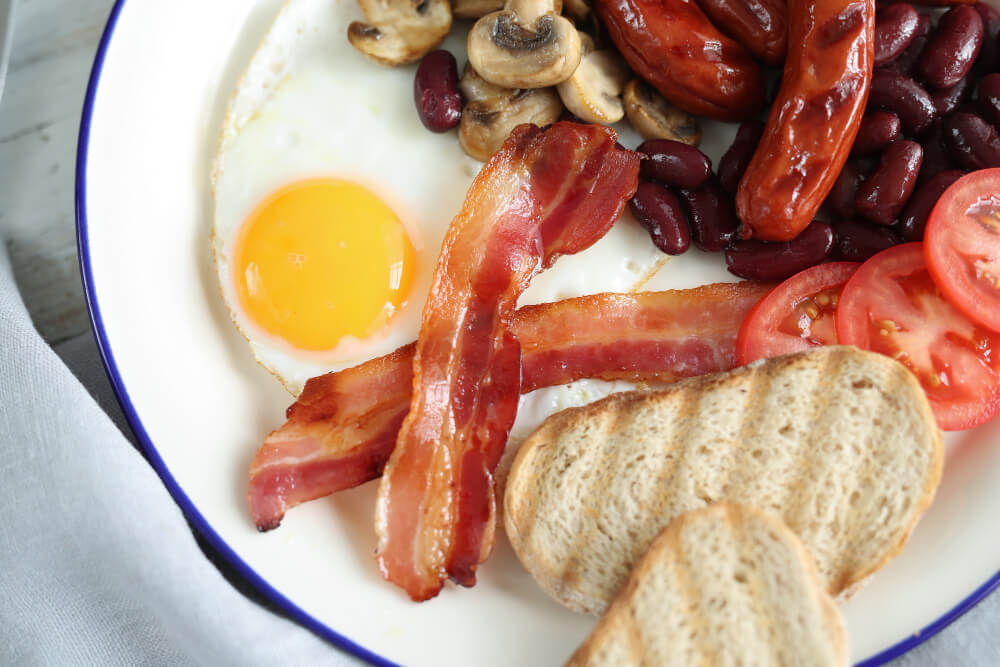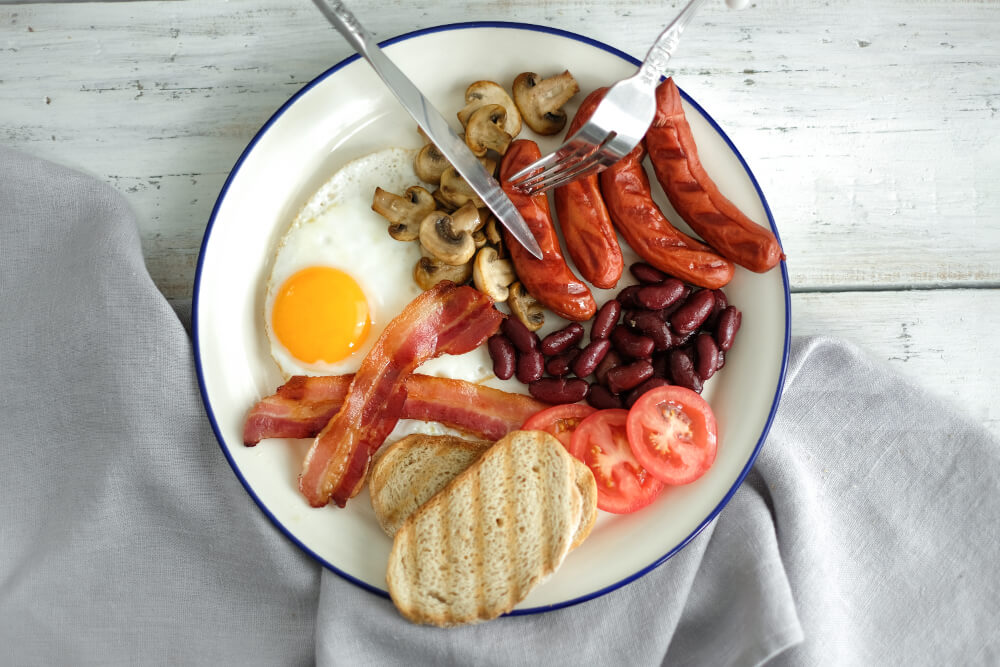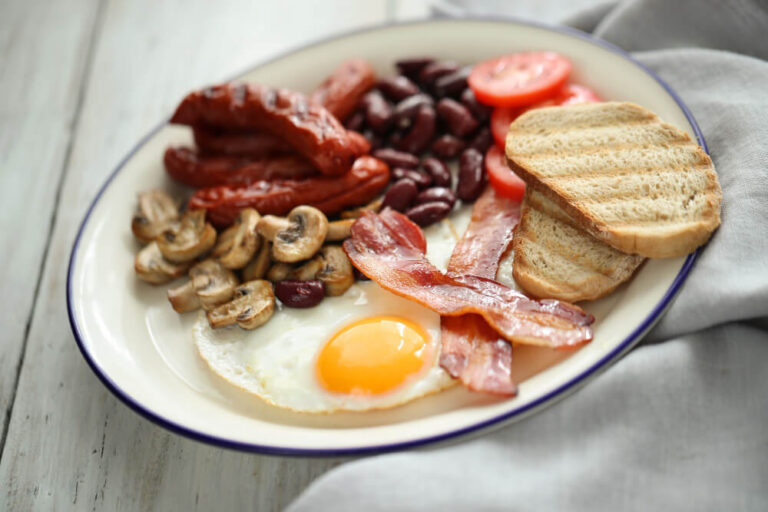An English breakfast is more than just a meal. It’s a cherished British tradition with deep roots in history and culture. Famous for its hearty mix of savory delights, this iconic staple excites food lovers worldwide. Let’s explore what makes the English breakfast so special and why it remains a culinary favorite.
What is a Traditional English Breakfast?
A traditional British breakfast, often called a “fry-up,” combines eggs, bacon, sausages, baked beans, tomatoes, mushrooms, and toast. This satisfying meal often includes English Breakfast tea, which pairs perfectly with its rich flavors.
According to The History of British Breakfasts, the tradition began in the Victorian era. At the time, large breakfasts symbolized wealth and hospitality. While the meal has evolved, its core ingredients remain true to its rustic origins.
The Historical Roots of the English Breakfast
The full British breakfast has a long and fascinating history. It started with the English gentry, who enjoyed extravagant feasts. Over time, it became a staple for workers during the Industrial Revolution. This hearty meal gave them energy for long days of labor.
As noted by British Culture and Cuisine, the fry-up became a symbol of British identity. Its popularity grew through books, films, and TV, cementing its place in popular culture.
Components of a Classic English Breakfast
The traditional English breakfast is famous for its variety. Each ingredient plays a crucial role in creating a balanced meal. Here are the key elements:
- Eggs: Typically fried but often scrambled or poached.
- Sausages: Usually pork, though vegetarian options are now available.
- Bacon: British-style bacon, combining fat and lean meat, adds texture.
- Baked Beans: Sweet and tangy, these balance the meal.
- Grilled Tomatoes: Juicy and acidic, they enhance the flavors.
- Mushrooms: Sautéed for a soft, earthy taste.
- Black Pudding: A bold sausage made with oats, fat, and blood.
Together, these ingredients deliver a meal that satisfies every taste.
For healthier options, try plant-based adaptations like those in Vegetarian Breakfast Recipes. These swaps maintain the essence of the dish while meeting dietary preferences.
Variations of the British Breakfast
The English breakfast takes on unique twists across the UK. Regional adaptations add variety while staying true to its hearty nature.
The Scottish Breakfast
- Includes haggis and tattie scones for a distinct Scottish touch.
The Irish Breakfast
- Features white pudding and soda bread as local favorites.
The Welsh Breakfast
- Adds laverbread and cockles, highlighting traditional Welsh ingredients.
These regional spins showcase the dish’s versatility and cultural richness. Learn more about them with the Full Irish Breakfast Guide.
English Breakfast Tea: The Perfect Companion
No discussion of a traditional English breakfast is complete without mentioning English Breakfast tea. This robust and flavorful tea complements the hearty meal, enhancing its taste while offering a refreshing start to the day.
What Is English Breakfast Tea?
English Breakfast tea is a blend of black teas, typically from Assam, Ceylon, and Kenya. It is known for its rich, bold flavor and deep color. Unlike lighter teas, this brew is strong enough to pair perfectly with the meal’s rich components. According to How to Brew English Breakfast Tea, the tea is best enjoyed with milk, though it can also be taken plain or with a slice of lemon.
How to Brew the Perfect Cup
Brewing English Breakfast tea requires attention to detail to ensure the best flavor. Follow these simple steps:
- Use freshly boiled water.
- Steep the tea leaves (or tea bag) for 3–5 minutes, depending on desired strength.
- Add milk, sugar, or lemon as per preference.
A well-brewed cup of tea can elevate the experience of an English breakfast, making it an essential part of the meal.
How to Make a Traditional English Breakfast at Home

Creating an authentic British Breakfast at home is easier than you might think. The key is preparation and attention to detail. Here’s a step-by-step guide:
Ingredients You’ll Need
- Eggs (2 per person)
- Sausages (2 per person)
- Bacon (2 rashers per person)
- Baked Beans (1 cup per person)
- Grilled Tomatoes (halved, 1 per person)
- Mushrooms (sliced, 1 cup per person)
- Black Pudding (optional, 1 slice per person)
- Toast (2 slices per person)
- Cooking oil or butter for frying
Step-by-Step Instructions
- Cook the sausages: Fry until golden brown, ensuring they are fully cooked.
- Prepare the bacon: Fry until crispy or to your preferred texture.
- Grill the tomatoes and mushrooms: Cook them in the same pan for added flavor.
- Heat the baked beans: Warm gently in a saucepan or microwave.
- Fry the eggs: Cook sunny-side-up or scrambled, depending on preference.
- Toast the bread: Serve with butter or jam.
Tips for Success
- Use high-quality ingredients to replicate the authentic taste.
- Serve everything hot to preserve the meal’s freshness.
- Pair with a steaming cup of English Breakfast tea.
For additional breakfast inspiration, check out the Cheese Omelette Guide for egg-centric options.
Modern Twists on the Traditional English Breakfast
The English breakfast has evolved to suit diverse tastes and dietary needs. Modern adaptations maintain its hearty essence while offering fresh takes that appeal to today’s health-conscious and adventurous eaters.
1. Health-Conscious Variations
Many people seek healthier ways to enjoy their favorite meals, and the English breakfast is no exception. Here are some popular adjustments:
- Replace fried eggs with poached or boiled eggs for a lighter option.
- Swap sausages and bacon for leaner turkey or chicken versions.
- Include sautéed spinach or avocado slices for added nutrients.
- Use whole-grain toast instead of white bread for a fiber boost.
2. Creative Fusion Ideas
Combining traditional elements with global flavors has led to exciting fusion dishes:
- Breakfast Wraps: Wrap the classic components in a tortilla for a portable meal.
- Shakshuka-Style Beans: Replace baked beans with spiced tomato and egg dishes.
- Full Breakfast Pizza: Use a flatbread base topped with eggs, bacon, and tomatoes.
For more modern breakfast ideas, explore the Easy Breakfast Burrito Recipe for a fresh twist.
Vegetarian and Vegan Variations of the British Breakfast
Vegetarian and vegan lifestyles are growing in popularity, and the English breakfast adapts well to these diets. Plant-based ingredients can replace traditional meat while maintaining the dish’s comforting appeal.
Vegetarian Adaptations
- Use vegetarian sausages made with soy, lentils, or vegetables.
- Substitute black pudding with veggie patties or grilled halloumi.
- Add grilled sweet potatoes or roasted bell peppers for variety.
Vegan-Friendly Options
- Replace eggs with tofu scramble or chickpea omelets.
- Use vegan bacon and sausages made from pea protein or jackfruit.
- Swap buttered toast for slices spread with vegan butter or avocado.
- Incorporate grilled eggplant or zucchini for extra flavor.
For additional plant-based breakfast ideas, try recipes like the Spinach and Feta Grilled Cheese, which can be adapted for vegan diets.
Frequently Asked Questions About the English Breakfast
What is a Traditional English Breakfast?
A traditional English breakfast is a hearty meal that typically includes eggs, bacon, sausages, baked beans, tomatoes, mushrooms, and toast. It is often accompanied by English Breakfast tea and is considered a cornerstone of British cuisine.
Why Do Brits Eat Baked Beans for Breakfast?
Baked beans became a staple of the English breakfast during the mid-20th century. Their affordability and convenience made them a popular addition. Their slightly sweet and tangy flavor balances the richness of the other components.
What is a Full American Breakfast?
A full American breakfast differs from the English breakfast. It usually includes items like pancakes, waffles, bacon, eggs, and hash browns, often served with syrup or jam.
What’s the Difference Between a Full Scottish and Full English Breakfast?
The main difference lies in the regional specialties. A full Scottish breakfast includes items like haggis and tattie scones, while a full English breakfast focuses on components like black pudding and baked beans.
How Can Vegetarians Enjoy an English Breakfast?
Vegetarians can replace sausages and bacon with plant-based alternatives, grilled halloumi, or additional vegetables like sweet potatoes and zucchini. Tofu scramble can substitute for eggs.
For more variations, visit Vegetarian Breakfast Recipes to explore creative and tasty options.
Nutritional Information and Health Considerations
While delicious, a traditional British breakfast is often high in calories and fat. Moderation and mindful preparation can make it a balanced part of your diet.
Caloric Breakdown (Per Standard Serving)
- Eggs: 140 calories (two fried eggs)
- Bacon: 90 calories (two rashers)
- Sausages: 160 calories (two medium)
- Baked Beans: 120 calories (one cup)
- Tomatoes and Mushrooms: 50 calories
- Black Pudding: 90 calories (one slice)
- Toast: 80 calories (two slices with butter)
Tips for a Healthier Meal
- Choose leaner cuts of bacon and sausages.
- Grill or bake components instead of frying them.
- Opt for whole-grain toast and low-sugar baked beans.
- Include fresh fruit or a side salad for balance.
For lighter breakfast ideas, explore Healthy Breakfast Tips.
Cultural Significance of the English Breakfast

The English breakfast is more than just a meal; it represents British heritage and tradition. It has been a staple in homes and cafes for generations, symbolizing comfort and community. This meal reflects the nation’s agricultural roots, showcasing locally sourced ingredients like eggs, bacon, and mushrooms.
Historically, the English breakfast gained prominence among the gentry in the 19th century. Wealthy families showcased their hospitality through lavish morning spreads, which later influenced middle and working-class households. The Industrial Revolution popularized the meal further as a source of energy for workers starting their day.
Today, the English breakfast is synonymous with British culture. Many tourists flock to traditional cafes and pubs to experience it firsthand. Its international appeal has also grown, making it a recognized symbol of Britain worldwide.
The British Breakfast in Popular Culture
The English breakfast frequently appears in films, books, and TV shows, reinforcing its cultural status. Its depiction often conveys themes of tradition, comfort, or indulgence. Here are a few notable examples:
- Movies: The iconic fry-up scene in The Full Monty captures the meal’s role in everyday British life.
- Television: Series like Downton Abbey highlight elaborate breakfasts, showcasing their historical significance.
- Literature: British authors often describe the meal in vivid detail, emphasizing its hearty nature.
Additionally, celebrities and chefs worldwide celebrate the English breakfast. Its presence on social media platforms further cements its global appeal, with hashtags like #FullEnglishBreakfast trending among food enthusiasts.
For those looking to modernize this classic, try the Chicken and Waffles Recipe for a unique twist.
The Timeless Charm of the British Breakfast
The English breakfast is more than just a meal—it’s a celebration of tradition, flavor, and British culture. Its enduring appeal lies in its ability to adapt while staying true to its roots. Whether enjoyed in its classic form or through modern twists, this iconic dish continues to unite people over a shared love for hearty, satisfying food.
From its origins in the homes of English gentry to its role as a global culinary symbol, the English breakfast represents comfort, community, and versatility. It accommodates diverse dietary preferences, offering variations like vegetarian, vegan, and fusion-inspired creations. Paired with a perfectly brewed cup of English Breakfast tea, it delivers a complete sensory experience.
As you savor this meal—whether at home or abroad—you’re partaking in a rich legacy that spans generations. The next time you prepare or enjoy a traditional English breakfast, take a moment to appreciate the history and flavors that make it so beloved.
For further inspiration, explore recipes like the Fluffy Pancakes for a sweet breakfast alternative or the Quiche Lorraine Recipe for a French twist.
Enjoy your next English breakfast and keep the tradition alive!

